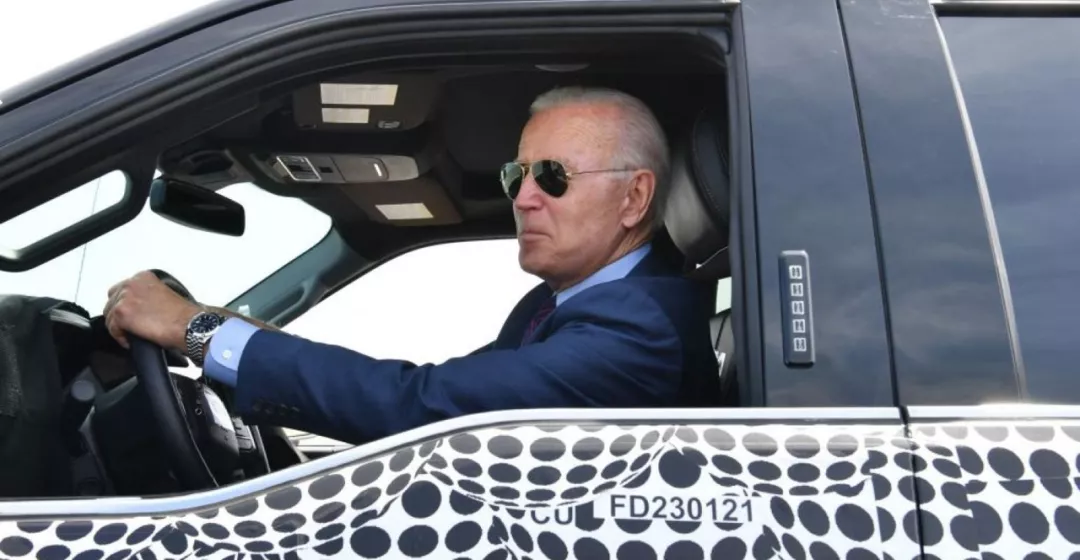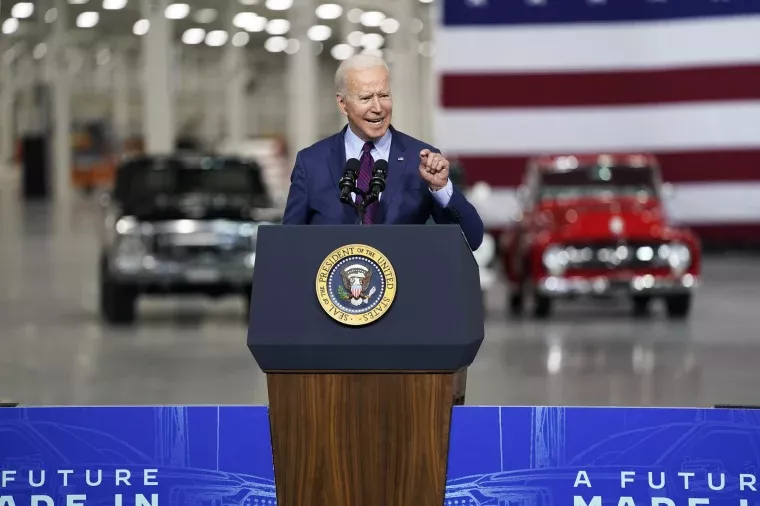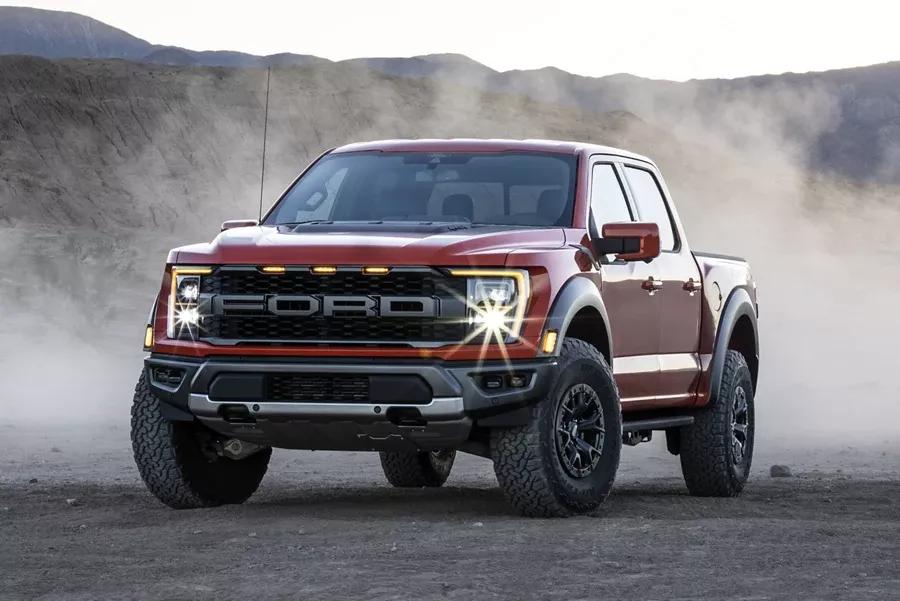The Media of BaiRenHui: Focusing on the Evolution of Automobile Travel Industry
Every automotive powerhouse has a representative model, a cultural symbol and emblem.
In Japan, that car is Toyota Corolla; in Germany, it’s Volkswagen Golf; and in the US, the symbol is Ford F-150. For 44 years, the Ford F-Series pickup has been the best-selling pickup truck in North America, and its throne has never been disrupted. In 2020, the Ford F-Series pickup sold more than 770,000 units, accounting for approximately one-fifth of Ford’s total annual sales.
Now, as automotive companies globally push for electric transformation, Ford is attempting to prepare its sales champion and totem F-150 for a “revolutionary” electric transformation.
On May 20, Ford held a pre-sales conference for the pure electric version of the F-150, the F-150 Lightning, at the Rouge Factory in Michigan, USA.
For Ford, the F-150 Lightning is crucial. On one hand, it needs to inherit the market share and reputation accumulated by the Ford F-Series pickups for many years; on the other hand, it needs to carry Ford’s electric transformation banner with the physique of the time-honored classic.
The F-150 is also crucial to the US automobile industry. With a variety of pure electric vehicles emerging in China, Tesla remains dominant in the US pure electric vehicle market. The US needs more Model 3, Model Y, and Cybertruck.
Can the F-150 continue the glory and dreams of Ford pickups and American vehicles?
National Car to National Electric Car?
Whether it’s Bill Ford, the chairman of Ford Motor Company, or the trailer shown at the F-150 release event, both emphasize the fact that Ford F-Series pickups have been the best-selling pickup truck in the US for the past 44 years.
No other car can fit the adventurous and free-spirited Americans better than the tough and powerful pickup truck. Large size, practicality, versatility, and relatively affordable price make pickups very popular in the US. In the US, pickups account for nearly 25% of the over 14 million new cars sold every year.
Among all the best-selling pickups, none is more deserving of the title of “American national car” than the Ford F-150. The F-150 currently offers six configurations from low to high, with prices ranging from USD 28,940 to USD 70,825 (approximately RMB 185,400 to RMB 453,700). The wide price range and significant configuration differences allow the F-150 to appeal to different social classes in the US.
Under Ford’s management and consumer support, the F-Series launched in 1948 and continues to thrive. The F-150, with its large sales volume, has become a spiritual totem within American automobile culture.However, the F-150, which is Ford’s cash cow with plenty of power, has also brought huge troubles to Ford due to its large engine displacement and massive size. Last year, there was news that Ford would purchase carbon emission credits from competitors to avoid massive fines, and the F-150 was at the forefront of this burden.
There is no doubt that the trend of electrifying automobiles is irreversible. On May 20th, after three years of development, the pure electric version of the F-150 was unveiled at its pre-sale launch event. Prior to the event, Ford named this vehicle the F-150 Lightning, paying tribute to a classic model of the same name in the F-series history, with the implication that the F-150 Lightning will lead the way with thunder and lightning, and open up the American pure electric pickup truck market.
Ford stated that they have made revolutionary innovations to the F-150 Lightning.
“Revolutionary innovation” undoubtedly refers to the electric powertrain system on the new vehicle. The F-150 Lightning is equipped with front and rear dual motors that can output up to 420kW of power and a maximum torque of 1050N·m. As for the 0-100km/h acceleration time, although Ford has not yet released specific data, it is stated that the vehicle’s performance will be in the “mid-4-second range” at delivery. Depending on the battery capacity, the range will be available in two versions: 230 miles (about 370 kilometers) and 300 miles (about 483 kilometers). It should be noted that the range is measured under the strict US EPA standard and has a high level of practical reference.
Due to the large two battery packs (reportedly 120kWh and 160kWh), Ford has also developed a powerful “reverse charging” function for the F-150 Lightning, which can output a maximum of 9.6kW of power to serve as an emergency power source for the entire home during power outages.
In terms of intelligent functions, the high-end version of the F-150 Lightning is equipped with BlueCruise, an automatic driving assistance function similar to General Motors’ SuperCruise, which can support hands-free driving on North American highways. At the same time, the F-150 Lightning is equipped with the newly developed Ford Sync 4A vehicle system, which not only has a larger and smoother in-car screen, but also has a more intelligent voice assistant and comes standard with OTA functionality.On the other hand, the F-150 Lightning also inherits the most basic characteristics of a national pickup truck – it is able to carry goods with a maximum load capacity of up to 2,000 pounds (approximately 907 kilograms) in the cargo bed, which can hold a considerable amount of cargo even after removing the engine from the 400-liter front trunk. Additionally, its towing capacity reaches up to 10,000 pounds (approximately 4.5 tons), making it capable of effortlessly towing a large RV. Moreover, the F-150 Lightning essentially inherits the well-established front face design of the gasoline version, which has deeply ingrained itself in people’s minds.
In terms of vehicle quality, the F-150 Lightning has achieved almost comprehensive superiority over its gasoline model predecessor, except for its range. As a result, the starting price has also increased to $39,974 (approximately RMB 256,000). However, because consumers can enjoy a subsidy of $7,500 (approximately RMB 48,000) when purchasing the vehicle, the post-subsidy price of the F-150 Lightning is actually not much higher than that of the gasoline version.
For such a classic and innovative vehicle model that combines both cost-effectiveness and emotion, the American public has expressed overwhelming support. According to Ford’s official data, more than 50,000 orders were received within 48 hours after the new vehicle was released. The once national car of America may have already shown signs of becoming the new generation of national electric vehicles.
Is this Ford’s new hope?
These 50,000 orders must have brought a sigh of relief to Ford.
In recent years, Ford has not had an easy time – it has suffered a Waterloo in the Chinese market and has continued to strategically shrink its business in the US market, only producing high-profit vehicle types such as SUVs and pickups. The management of Ford has also frequently experienced turmoil.
Ford’s pickup trucks, led by the F-150, have played a significant role in supporting Ford’s business over the past few years. However, over the past three years, Ford’s pickup truck sales have also continued to decline, with annual sales in its North American home base falling from over 900,000 units to 770,000 units, resulting in a weakened market dominance. Competitors such as Dodge’s Ram, Nissan’s Titan, and other upcoming electric pickup truck models are chasing closely behind.
Last year, Tesla shamelessly released a video of the CyberTruck crushing the F-150 at a tug-of-war competition during the CyberTruck unveiling event, ridiculing the traditional vehicle. Yet, until now, the official delivery time of the CyberTruck is still uncertain, while the F-150 Lightning is scheduled to begin deliveries in the spring of next year.In 2022, it is expected that there will be four new electric pickup trucks vying for the American market, including Tesla’s CyberTruck, Ford’s F-150 Lightning, Rivian’s R1T backed by Ford investments, and General Motors’ Hummer EV under the GMC brand.
Among these four trucks, the F-150 Lightning may not have the sci-fi appearance of the CyberTruck or the amazing three- or four-motor configuration of the Hummer EV and R1T, but it definitely has the most popular appeal.
The F-150 Lightning, which is eligible for full subsidies, is expected to be the most affordable electric pickup truck, with a subsidized price of about $32,000 (approximately RMB 205,000), even cheaper than the SuperCrew base gasoline version (which is priced at $36,000). Except for some changes that highlight its pure electric identity, the F-150 Lightning is identical to traditional pickup trucks, making it easy for existing truck owners to switch.
Compared to its competitors’ high-end tendencies, the F-150 Lightning’s goal is undoubtedly to be the new generation’s electric car for the masses. The Verge, a US technology media outlet, also referred to it as “An electric truck for the masses.” There are also rumors that the F-150 Lightning may release a cheaper single-motor version in the future, further opening up a larger market.
However, the F-150 Lightning also faces some adversity – in the global automotive chip shortage, Ford has been forced to cut production, including some high-profit pickup truck models. If the chip shortage continues, the F-150 Lightning’s production capacity may be limited or even unable to meet market demand, which will be a significant blow to its sales.
The President of the United States promotes sales, “Rebuilding American Auto Glory”
However, at least for now, Ford can continue to revel in the joy of the continuous increase in F-150 Lightning orders. This is closely related to the personal promotion of F-150 Lightning by President Biden the day before the launch event.
On the day before the F-150 Lightning launch event, Biden visited the Ford Rouge plant, where F-150 Lightnings are manufactured, and personally test drove a F-150 Lightning that was still camouflaged. Biden stepped on the accelerator until the car reached 80 miles/hour. Before departing, Biden also inquired about the F-150 Lightning’s 0-100 km/h acceleration performance, and was told it was “4.3-4.4 seconds.”
“This thing is fast!” Biden exclaimed.
After Joe Biden visited the Ford electric pickup truck factory, the news was broadcasted for two days on major U.S. television news networks, undoubtedly giving the national pickup truck the best advertisement it could ever have received.
This was a move made by Biden to revive former president Obama’s legacy of electric vehicle politics and to mobilize the $174 billion (approximately RMB 1.1148 trillion) spending on automotive industry transformation in his infrastructure plan.
Ten years ago, during Obama’s presidency, he was the first to inspect the Chevrolet Volt extended-range electric vehicle under General Motors and announced a series of policies that were favorable for the development of pure electric vehicles. Unfortunately, the Volt gradually declined, while Tesla continued to rise.
Ten years later, at the Rouge plant, Biden firmly stated that the future of the automotive industry is electrification and cannot be reversed. He then emphasized, “China is leading the race for pure electric vehicles, this is a fact,” and “we have invested more in scientific research than any other country, and China was ranked eighth or ninth, and now they are first. We cannot continue like this.”

In his speech, Biden also mentioned that 80% of the world’s battery production capacity is in China. At the same time, he also explained the $174 billion stimulus plan for the automotive industry that was proposed earlier.
Two days after Biden visited Ford’s factory, the strategic cooperation plan between Ford and SKI was successfully implemented, and both parties plan to establish a joint venture company and build a 60GWh capacity battery factory in North America, which is scheduled to start production in 2025. Earlier this year, Ford announced that it would invest $22 billion (approximately RMB 140.9 billion) in the field of intelligent electric vehicles by 2025. The battery joint venture with SKI should be a part of it.
In Biden’s view, the United States is already lagging behind in the field of electric vehicles. Not only should the market scale be expanded, but also manufacturing should be strengthened, industrial chains should be established, and more jobs should be created. Therefore, while Biden prepares $174 billion in subsidies for consumers, automakers, and industrial chains in his stimulus plan, he also leads by example, bringing business to Ford that is willing to keep manufacturing in the United States.
The F-150 Lightning, born under the “Biden Administration,” has been given a special mission to “revive the glory of American car manufacturing.”
As for the Chinese market, there is also good news: the F-150 Lightning may expand its market by entering China.Last year, domestic media broke the news that, under the increasingly relaxed policies towards pickup trucks, the F-150 Raptor is expected to be introduced into China and produced domestically by JMC Ford. However, in the Shanghai Auto Show in April this year, the President and CEO of Ford China, Chen Anning, neither confirmed nor denied the news.
In fact, in the expanding Chinese pickup truck market, the F-150 Lightning, as a passenger pure electric pickup truck, occupies a unique ecological position. Taking into account China’s policy support for pure electric vehicles, there is a possibility for the F-150 Lightning, the “glory of America”, to be produced domestically.
This article is a translation by ChatGPT of a Chinese report from 42HOW. If you have any questions about it, please email bd@42how.com.
